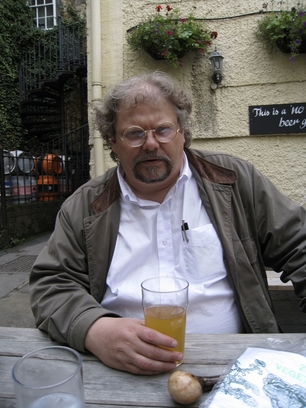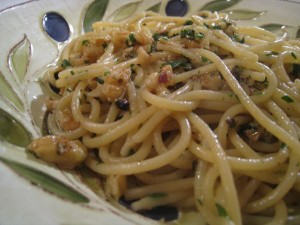Symposiasts at Work: Anthony F. Buccini
Andrew Dalby introduces Symposiast Anthony F. Buccini

Image credit: Anthony Buccini
Anthony first attended the Symposium in 2005. Since then he has not missed a year. Each year he has presented a paper, and each of those eleven papers has duly appeared in the Proceedings. That’s already an enviable record, because the competition to get a paper accepted is ever greater. Add the fact that his first, ‘Western Mediterranean Vegetable Stews and the Integration of Culinary Exotica’, won the Sophie Coe Prize for 2005, and it becomes clear that he must be doing something right …
How did he first arrive at the Oxford Symposium? And why food history? I asked those questions and this was Anthony’s reply:
I grew up in a family whose culinary culture was southern Italian and very loyal to tradition, with a typical southern Italian weekly template of meal types. As with many Italian families, food discourse was part of daily life. At the age of 22, I moved off to Belgium to study Germanic linguistics and there I had a couple of challenges facing me with regard to food: I was quite enthusiastic about exploring Belgian foodways but, as I lived on my own, I had to find a way to recreate in my own tiny apartment the familiar southern Italian diet I had grown up with. In the early 1980s, before Italian food products were to be found everywhere, it required a fair amount of work for me to get many of the things I had grown up with in Belgium. My shopping trips to Brussels’ south side ended up being more and more adventuresome. In short, I did manage to recreate my family’s Italian home-cookery but also became fascinated with Arab foods, Greek cuisine, Belgian cookery, etc. By the time I returned to the States to attend graduate school at Cornell, I was regularly buying cook books and starting to think about ‘cuisine’ from historical and anthropological perspectives.
He noticed that cookbook authors would often offer historical and cultural background revolving around etymologies that seemed absurd to a historical linguist. And so, teaching at the University of Chicago in the 1990s, he set to work on food etymologies ‘as a sort of hobby,’ Anthony explained. ‘When I became aware of the Oxford Symposium in 2004, I decided to try writing an academic piece in the field of food history and that ended up being my 2005 paper.’
That 2005 paper opened up a subject to which he would return – summer vegetable stews, thought of as typically Mediterranean in character, emblematic for local cuisines, such as ratatouille in Provence, cianfotta in Campania, and xamfaina in Catalonia, all featuring vegetables introduced to the region in the late middle ages or from the Americas. These ‘exotic’ ingredients, he showed, were embraced by the lower classes but eschewed by the elite. Names such as Catalan xamfaina/samfaina and Campanian cianfotta were originally jocular names for peasant offal stews … yes, offal! That being the theme of the 2016 symposium, this must be the ideal moment to revisit the topic and take it to a new continent, under the promised title ‘Un vrai jambalaya — “a real mess”: The Complex Western Mediterranean Origins of Louisiana’s Famous Dish’.
Below is a list of Anthony’s published papers in food history. His first book-length work in the field, From Green to Gold: Olive Oil and the History of Mediterranean Foodways is in preparation, to be published by Columbia University Press. But there’s more. He also writes on historical linguistics, especially Western Germanic languages (German, Dutch, English) … with a glance at Pidgin Delaware. Thanks to his studies in Belgium he is a fluent speaker and writer of Dutch (a fairly unusual accomplishment for a non-native) and this, too, will be evident from the bibliography below.

Image credit: Anthony Buccini
Spaghetti con alici e noci is for some families in Campania a required part of the Christmas Eve meal, a feast which occurs on a ‘fast day’, that is, a day when one must abstain from all animal products (meat, dairy, eggs). It is a very typical and likely very old pasta preparation which contains no tomato or other American (via Columbian Exchange) elements, though one can use a piquant ‘peperoncino’ to supplement the copious amount of black pepper one normally uses in this dish.
Ingredients: spaghetti, olive oil extra virgin, garlic, black pepper, parsley, walnuts, and either (fermented) salted anchovies OR, in place of the anchovies, one can use ‘colatura di alici’, a modern form of garum which is made of the juice exuded by fermenting salted anchovies, produced in the Provincia di Salerno (Amalfi Coast), just south of Naples.
Anthony Buccini on food history
“Defining ‘Cuisine’: Communication, Culinary Grammar and the Typology of Cuisine.” In press. In: Food and Communication: Proceedings of the Oxford Symposium on Food and Cookery 2015. Mark McWilliams (ed.). Totnes: Prospect Books.
Entries on “Italian Beef” and “Greeks in Chicago.” In press. In: Food City: The Encyclopedia of Chicago Food. Bruce Kraig and Colleen Sen (eds.). Urbana: University of Illinois Press.
“Prejudice, Assimilation, and Profit: The Peculiar History of Italian Cookery in the United States.” Forthcoming. In: Food, Identity and Social Change. Cynthia Chou & Suzanne Kramer (eds.)
“The Merchants of Genoa and the Diffusion of Southern Italian Pasta Culture in Europe.” 2015. In: Food and Markets: Proceedings of the Oxford Symposium on Food and Cookery 2014. Mark McWilliams (ed.), pp. 54-64. Totnes: Prospect Books.
“Italian.” 2015 In: Ethnic American Food Today: A Cultural Encyclopedia, Lucy Long (ed.), pp. 314-323. Lanham, MD: Rowman & Little.
Entries on “Carnival,” “Crescent,” “Holiday Sweets,” “Perugina,” and “Tutti-frutti.” 2015. In: The Oxford Companion to Sugar and Sweets. Darra Goldstein (ed.). Oxford: Oxford University Press.
“The Shape of Things to Come: Bottles, Glasses and Contrasting Beer Cultures in Belgium and the United States.” 2014. In: Food and Material Culture: Proceedings of the Oxford Symposium on Food and Cookery 2013. Mark McWilliams (ed.). pp. 80-89. Totnes: Prospect Books.
“Lasagna: A Layered History.” 2013. In: Stuffed and Wrapped Foods: Proceedings of the Oxford Symposium on Food and Cookery 2012. Mark McWilliams (ed.), pp. 94-104. Totnes: Prospect Books.
“Linguistics and Food Studies: Structural and Historical Connections.” 2012. In: Routledge International Handbook of Food Studies. Ken Albala (ed.), pp. 146-58.
“Continuity in Culinary Aesthetics in the Western Mediterranean: Roman Garum and Liquamen in the Light of Local Survival of Fermented Fish Seasonings in Japan and the Western Mediterranean.” 2012. In: Cured, Fermented and Smoked Foods: Proceedings of the Oxford Symposium on Food and Cookery 2011. Helen Saberi (ed.), pp. 66-75. Totnes: Prospect Books.
“Chi vuol godere la festa, digiuni la vigilia: On the Relationship between Fasting and Feasting.” 2011. In: Celebration: Proceedings of the Oxford Symposium on Food and Cookery, 2010. Mark McWilliams (ed.), 66-75. Totnes: Prospect Books.
“The Anatolian Origins of the Words ‘Olive’ and ‘Oil’ and the Early History of Oleïculture.” 2010. In: Food and Language: Proceedings of the Oxford Symposium on Food and Cookery 2009. Richard Hosking (ed.), 52-61. Totnes: Prospect Books.
“The Bitter – and Flatulent – Aphrodisiac: Synchrony and Diachrony of the Culinary Use of Muscari Comosum in Greece and Italy.” 2009. In: Vegetables: Proceedings of the Oxford Symposium on Food and Cookery 2008. Susan R. Friedland (ed.), pp. 46-55. Totnes: Prospect Books.
“From Necessity to Virtue: The Secondary Uses of Bread in Italian Cookery.” 2008. In: Food and Morality: Proceedings of the Oxford Symposium on Food and Cookery 2007. Susan R. Friedland (ed.), pp. 57-69. Totnes: Prospect Books.
“On Spaghetti Alla Carbonara and Related Dishes of Central and Southern Italy.” 2007. In: Eggs in Cookery: Proceedings of the Oxford Symposium on Food and Cookery 2006. Richard Hosking (ed.), pp. 36-47. Totnes: Prospect Books.
“Western Mediterranean Vegetable Stews and the Integration of Culinary Exotica.” 2006. In: Authenticity in the Kitchen: Proceedings of the Oxford Symposium on Food and Cookery 2005. Richard Hosking (ed.), pp. 132-45. Totnes: Prospect Books
Anthony Buccini on historical linguistics
“Between Pre-German and Pre-English” The Origin of Dutch.” 2010. Journal of Germanic Linguistics 22.4: 301-314.
“In Memoriam Frans van Coetsem.” 2003. Journal of Germanic Linguistics 15.3: 269-77. Entries on “Italian Beef” and “Greeks in Chic
“Ab Errore Liberato. The Northern Expansion of Frankish Power in the Merovingian Period and the Genesis of the Dutch Language.” 2003. In: Quod Vulgo Dicitur: Studien zum Altniederländischen (Amsterdamer Beiträge zur Älteren Germanistik 57), W. Pijnenburg, A. Quak and T. Schoonheim (eds.). Amsterdam/New York: Radopi.
“Swannekens ende Wilden: Linguistic Attitudes and Communication Strategies among the Dutch and Indians in New Netherland.” 2000. The Low Countries and the New World(s): Travel, Discovery, Early Relations, (Publications of the American Association for Netherlandic Studies, 13), Johanna C. Prins, Bettina Brandt, Timothy Stevens and Thomas F. Shannon (eds.), pp. 11-28.
“Dutch, Swedish, and English Elements in the Development of Pidgin Delaware.” 1999. American Journal of Germanic Linguistics and Literatures 11.1: 63-87.
“Germanic Languages.” 1997a. Co-authored with William Moulton. Encyclopaedia Britannica: Macropaedia, vol. 22, pp. 639-49.
“Germanic Languages.” 1997b. Encyclopaedia Britannica: Micropaedia, vol. 5, p. 213.
“New Netherland Dutch, Cape Dutch, Afrikaans.” 1996a. Taal en Tongval (Themanummer 9, Afrikaans en varieteiten van het Nederlands, P. van Reenen, H. den Besten, F. Ponelis and J. Goossens (eds.)), pp. 35-51.
“Edward Prokosch.” 1996. Lexicon Grammaticorum. Harro Stammerjohann (ed.). Tübingen.
“William Freeman Twaddell.” 1996. Lexicon Grammaticorum. Harro Stammerjohann (ed.). Tübingen.
“Ontstaan en vroegste ontwikkeling van het Nederlandse taallandschap” (Origins and Earliest Development of the Dutch Language Area). 1995a. Taal en Tongval 48 (Themanummer 8, Historische dialektologie, J. Taeldeman, J. Goossens and J. Berns (eds.)), pp. 8-66.
“The Dialectal Origins of New Netherland Dutch.” 1995b. The Berkeley Conference on Dutch Linguistics 1993. Thomas F. Shannon and Johan P. Snapper (eds.), pp. 211-63. Lanham, MD: University Press of America.
“Southern Middle English Hise and the Question of Pronominal Transfer in Language Contact.” 1992. In: Recent Developments in Germanic Linguistics. (Selected Papers from the Second Annual Michigan/Berkeley Germanic Linguistics Roundtable, University of Michigan, April 1991.) Rosina Lippi-Green (ed.), pp. 11-32. Amsterdam: John Benjamins.
“Variation and the Reconditioning of Phonological Rules: Cases from Germanic and Romance.” Co-authored with Frans van Coetsem. 1990. Lingua 81: 169-220.
“Umlaut Alternation, Variation and Dialect Contact: Reconditioning and Deconditioning of Umlaut in the Pre-History of the Dutch Dialects.” 1990. In: Synchronic and Diachronic Approaches to Linguistic Variation and Change. (Selected Papers from Georgetown University Round Table on Languages and Linguistics, Georgetown University, March 1988.) Thomas J. Walsh (ed.), pp. 63-80. Washington, D.C.: Georgetown University Press.
